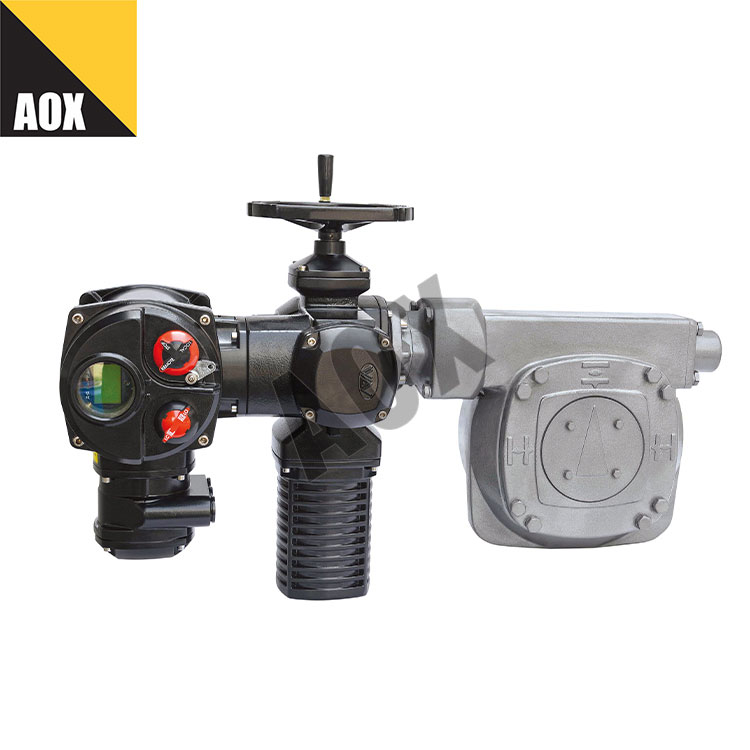
- English
- Español
- Português
- русский
- Français
- 日本語
- Deutsch
- tiếng Việt
- Italiano
- Nederlands
- ภาษาไทย
- Polski
- 한국어
- Svenska
- magyar
- Malay
- বাংলা ভাষার
- Dansk
- Suomi
- हिन्दी
- Pilipino
- Türkçe
- Gaeilge
- العربية
- Indonesia
- Norsk
- تمل
- český
- ελληνικά
- український
- Javanese
- فارسی
- தமிழ்
- తెలుగు
- नेपाली
- Burmese
- български
- ລາວ
- Latine
- Қазақша
- Euskal
- Azərbaycan
- Slovenský jazyk
- Македонски
- Lietuvos
- Eesti Keel
- Română
- Slovenski
- मराठी
- Srpski језик
How to select the right Electric Multi Turn Valve Actuator for your application?
2024-10-08

What are the key features to consider when selecting an Electric Multi Turn Valve Actuator?
When selecting an Electric Multi Turn Valve Actuator, it is crucial to consider the following features:
- Valve torque requirement
- Speed of operation
- Type of valve
- The size of the actuator
- Control system compatibility
- Environmental conditions
How does an Electric Multi Turn Valve Actuator work?
Electric Multi Turn Valve Actuators work by converting electrical energy into mechanical energy. The motor inside the actuator rotates a series of gears which operate the valve stem. As the motor rotates, the gears inside the gearbox turn, transmitting the torque to the valve stem. The actuator also features limit switches that allow it to sense the position of the valve and provide accurate feedback to the control system
What are the different types of Electric Multi Turn Valve Actuators?
There are several types of Electric Multi Turn Valve Actuators, including:
- Linear Electric Multi Turn Valve Actuators
- Rotary Electric Multi Turn Valve Actuators
- Part-Turn Electric Multi Turn Valve Actuators
- Heavy-Duty Electric Multi Turn Valve Actuators
- Quarter-Turn Electric Multi Turn Valve Actuators
What are the advantages of using Electric Multi Turn Valve Actuators?
The advantages of using Electric Multi Turn Valve Actuators include:
- Accuracy in valve positioning
- Remote valve operation
- Reduced maintenance costs
- Improved safety
- Energy efficiency
- Compact design
In conclusion, Electric Multi Turn Valve Actuators are a vital component in modern industrial automation. They provide accurate valve positioning, reliable operation, and improved safety in various applications. It is crucial to consider the valve torque requirement, speed of operation, and the type of valve when selecting an Electric Multi Turn Valve Actuator. With proper selection and installation, Electric Multi Turn Valve Actuators can significantly enhance the performance of industrial processes.
Zhejiang Aoxiang Auto-Control Technology CO.,Ltd is a leading manufacturer of Electric Multi Turn Valve Actuators. Our products are designed to provide precision control, reliability, and energy efficiency in various industrial applications. Visit our website at https://www.aox-privod.com to learn more about our products and services. For inquiries and orders, please contact us at zjaox07@zjaox.com
Scientific Papers:
1. J.L. Liu, L. Wang, G. Zhang, C. Xu, 2021, "Design and Experiment Research of High-Sensitive Magnetic Fluid Soft Valve Based on Microfabrication Technology," Micromachines, vol. 12, no. 5, p. 564.
2. S. Li, Y. Xu, Y. Guo, R. Zhang, C. Yan, 2020, "Intelligent Control Method of Depressurization Energy Consumption based on RBF Neural Network Optimized by Multi-objective Genetic Algorithm," Journal of Central South University, vol. 27, no. 5, pp. 1425-1435.
3. B. Zhang, L. Cui, X. Zhao, X. Zhang, Y. Wang, 2020, "Research on Thermal Performance of Supercritical Folw in Spiral Coil Tube Based on Numerical Simulation," Science and Technology Innovation Herald, vol. 17, no. 8, pp. 54-57.
4. C. Wang, L. Wei, H. Wang, Z. Li, J. Song, 2020, "Design and Development of High-Precision Flow Control Valve Based on Electromagnetic Proportional Technology," 2020 5th International Conference on Manufacturing and Industrial Technologies, pp. 666-669.
5. D. Pan, G. Jiang, 2021, "Adaptive Iterative Learning Control of Non-linear Valve-actuator Systems Considering Hysteresis," International Journal of Control, Automation and Systems, vol. 19, no. 6, pp. 1-14.
6. K. Lin, R. Kumar, Y. Lv, 2020, "Study on High Efficient Valve Modeling Method of Vibration Reduction Based on Nonlinear Optimization," International Journal of Heat and Technology, vol. 38, no. S1, pp. 16-21.
7. J. Wang, C. Ma, Q. Zhang, 2020, " Robust Sliding-Mode Control for a Class of Underactuated Systems with Model Uncertainty and Input Nonlinearity," Journal of Dynamic Systems, Measurement, and Control, vol. 142, no. 7, p. 071014.
8. Y. Luo, S. Shan, Y. Li, W. Lin, 2020, "Design and Development of an Intelligent Temperature Control Valve Based on Fuzzy Control Theory," 2020 IEEE 10th International Conference on Measuring Technology and Mechatronics Automation, pp. 422-426.
9. F. Zandavi, A. Yousefpour, 2020, "Novel Model-Based Control Strategy of the Supercritical Coal-Fired Power Plant," Energy Conversion and Management, vol. 219, p. 113086.
10. S. Guo, D. Li, C. Tian, 2020, "Numerical Analysis of Characteristics and Optimization of Hydrodynamic Torque Converter Spray System," Energy Reports, vol. 6, pp. 1040-1045.



